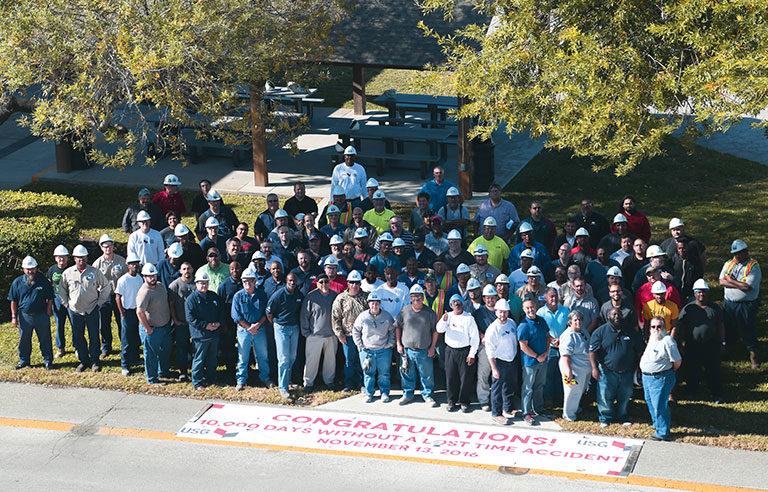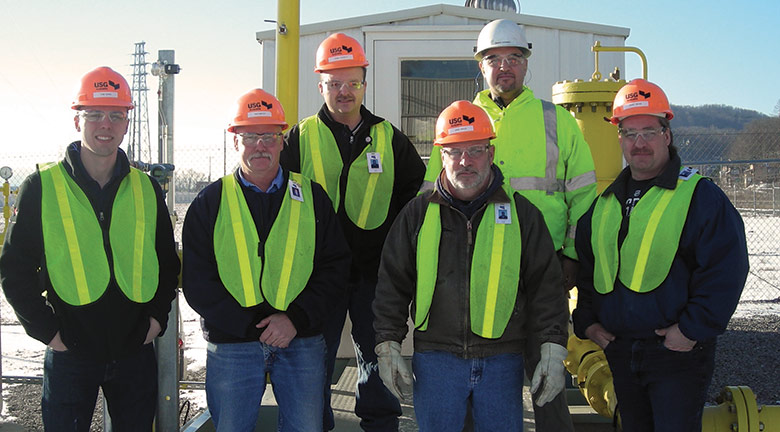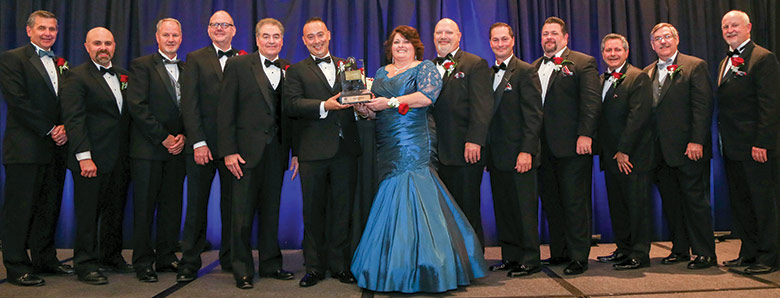'Wholly committed' to safety
USG Corp. is the latest recipient of the Robert W. Campbell Award

USG Corporation doesn’t use alphabetical order when outlining its organizational core values. “Safety, innovation, integrity, service, efficiency, diversity and quality” are listed in that sequence for a reason.
“We list safety as our first core value because it is,” USG President and CEO Jennifer Scanlon said. “For the 115 years that we’ve been in business, safety really has played an important role.”
USG’s exemplary environmental, health and safety culture has earned special recognition. The company is the most recent recipient of the Robert W. Campbell Award, presented annually by the Campbell Institute at the National Safety Council to an organization that successfully integrates EHS management with business operations.
Chicago-based USG produces building materials and technologies, counting approximately 6,600 employees across North America. During the award assessment process, Campbell Institute Program Manager Katherine Smith and her colleagues marveled at USG’s standard for employee engagement.
“By far, just being immersed in their culture, it was clear that every person in that organization was 100 percent behind USG,” Smith said. “They were wholly committed to the company.”
Employee dedication to safety
Employees exhibit equal enthusiasm for safety, continuing what Scanlon calls “a tremendous long-term history and focus.” Scanlon said 96 percent of USG’s 56 plant locations did not experience a lost-time injury in 2016.
And, according to NSC, USG’s lost-time injury rate was 17 times better than the industry average.
“When you visit any of our plants, it’s not just the sign on the door that mentions safety,” Scanlon said. “You’ll see T-shirts and jackets that talk about what safety milestone they reached. … I think it’s something that our employees feel really good about, that they can talk to their friends and families and really get this sense that we really care about them and they really care about each other.”
A Campbell Award panel performed on-site assessments at USG headquarters, as well as USG facilities in Michigan and Texas, spending approximately one day at each location. Many interview questions during the assessments were culture-based, gauging respondents’ knowledge of what they would do if they or a co-worker were injured on the job. The goal, Smith said, was to test policies already in place and record employees’ comfort in fulfilling them. During one facility visit, Campbell Award assessors asked a group of front-line employees whether they would encourage a family member to work at USG. Each participant answered affirmatively, but one particular response stood out.

Workers at USG’s plant in Aliquippa, PA, monitor the company’s natural gas substation, which supplies fuel to the plant’s wallboard line.
A man casually replied, “Well, we’re all family.”
Both extended and biological families work at USG.
“We see second and third generations in many of our plants and even in our corporate headquarters. This is the kind of place that people recommend for their children, their nieces, to work,” Scanlon said. “Because there is that level of commitment to employees.”
In Scanlon’s experience, that reality manifested itself early. A 14-year USG employee who ascended to the role of CEO in 2016, Scanlon vividly recalls separate plant visits that helped comprise her “indoctrination to USG.” In both cases, the actions of the employees personified the organization’s safety culture.
In one instance, Scanlon had offered assistance in attaching something to an office wall. She moved a chair and started to step up onto it when an employee cautioned her against the practice, reminding Scanlon she needed proper and safer support for the corresponding height.
During another visit, Scanlon and a colleague were crossing the street from a parking lot to a restaurant on a cold, rainy night. With traffic clear, Scanlon moved forward, aiming to cross against the traffic signal. Her companion, however, stopped Scanlon and reminded her that no situation should prompt safety to take a backseat.
“People are paying attention to everyone around them,” Scanlon said. “They’re paying attention to what’s going on. It makes us feel very connected.”
‘Trophy Tour’
USG recently started a Campbell Award trophy tour of sorts, transporting the award to each of the organization’s North American plants for employees to view.
“We have been celebrating this recognition tremendously within USG,” Scanlon said. “We are incredibly honored in being awarded the Campbell Award because it is so prestigious. When you look at the cadre of companies and corporations who have won it over the years, we take a lot of pride in being publicly acknowledged as the safety leader we feel we have been for the past 115 years.”

Plant safety committee presidents (at center) Noel Villarreal, Galena Park, TX, and Pam Caldwell, Detroit, MI, joined by USG’s manufacturing and safety leadership, accepted the Robert W. Campbell Award on behalf of their 6,600 co-workers at the 2016 National Safety Council Congress & Expo in Anaheim, CA.
Scanlon compares the trophy tour to the longstanding National Hockey League ritual of allowing each player from a championship team to keep the Stanley Cup for one day. In that respect, USG’s Senior Vice President, Manufacturing and Global Supply Chain, Pete Savu, is the de facto keeper of the Campbell Award, charged with maintaining proper upkeep.
Scanlon’s recent visit to the USG plant in Hagersville, Ontario, Canada, coincided with the appearance of the Campbell Award at that location.
Upon holding the award, Scanlon found it was quite “heavy” and “substantial.” Although she emerged without incident, Scanlon has little doubt any one of several employees was ready to offer a reminder on safe lifting protocol, if need be.
“I think that safety mindset is just ingrained in our employees and our organization,” Scanlon said. “And it feels good.”
Post a comment to this article
Safety+Health welcomes comments that promote respectful dialogue. Please stay on topic. Comments that contain personal attacks, profanity or abusive language – or those aggressively promoting products or services – will be removed. We reserve the right to determine which comments violate our comment policy. (Anonymous comments are welcome; merely skip the “name” field in the comment box. An email address is required but will not be included with your comment.)

